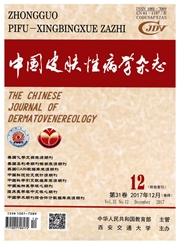

 中文摘要:
中文摘要:
目的 研究银屑1号对咪喹莫特诱导小鼠银屑病模型血清中炎性因子IL-6,IL-17,INF-γ和角质形成细胞内核转录因子-κB(NF-κB)及NF-κB mRNA表达的影响。方法 入选动物随机分为5组:正常组(Normal)、模型组(Model)、银屑1号高(HD)、中(MD)、低(LD)剂量组,除正常组外,所有小鼠外涂咪喹莫特软膏14日诱导为银屑病模型,银屑1号高、中、低剂量组给药剂量分别为50g/(kg·d),25g/(kg·d),12.5g/(kg·d),连续10d,正常组及模型组予等量生理盐水对照。检测表皮垂直厚度,血液蛋白芯片法检测血清I-L6,IL-17,INF-γ水平,苏木精-依红染色观察皮损组织结构改变,免疫组化法检测NF-κB含量,应用逆转录-聚合酶链反应检测NF-κB mRNA表达情况。结果 与正常组比较,模型组角质增厚,镜下T淋巴细胞浸润明显,其炎性因子、NF-κB蛋白及基因表达均升高(P〈0.01); 同模型组比较,银屑1号高、中剂量组IL-6,IL-17,INF-γ水平下降明显(P〈0.01); 高、中、低剂量组表皮增厚程度明显降低(P〈0.01),NF-κB蛋白水平明显降低(P〈0.01),中、低剂量组NF-κB mRNA表达降低(P〈0.05)。结论 银屑1号对银屑病小鼠模型的角质增殖和炎性反应具有抑制作用,抑制NF-κB蛋白及基因的过度表达是其作用机制之一。
 英文摘要:
英文摘要:
Objective To observe the effects of Yinxieyihao on inflammatory factors IL-6,IL-17,INF-γ in serum and nuclear factor kappa B,NF-κB mRNA in keratinocyte for imiquimod induced psoriasis mice model.Methods Mice were randomly divided into 5 groups:normal group,model group,Yinxieyihao high dose group(HD),middle dose group(MD),low dose group(LD). All mices were induced into psoriasis mices by Imiquimod Cream for 14 days except normal group,the doses of Yinxieyihao in HD,MD,LD were 50g/(kg·d),25g/(kg·d),12.5g/(kg·d),last 10 days. Normal and model group were given normal saline as control.Detected the thickness of epidermis,IL-6,IL-17,INF-γ levels of peripheral blood,HE staining were employed to observe the structural changes of skin issue,and the expressions of NF-κB protein and NF-κB mRNA were detected by IHC and PCR.Results Compared with normal group,the skin model group lesions were thickened,T lymphocytes infiltrated significantly,the expression of inflammatory factors,NF-κB protein and NF-κB mRNA increased in model group(P〈0.01); compared with model group,the level of IL-6,IL-17,INF-γ in HD and MD were obviously decreased(P〈0.01),the thickness of epidermis and the expression of NF-κB protein in HD,MD and LD were significantly reduced(P〈0.01),and the expression of NF-κB mRNA in MD and LD were declined(P〈0.05).Conclusion Yinxieyihao could inhibite the keratinocyte proliferation and inflammatory response in psoriasis mice model,over expression of inhibitory in NF-κB protein and NF-κB mRNA is one of its mechanisms.
 同期刊论文项目
同期刊论文项目
 同项目期刊论文
同项目期刊论文
 期刊信息
期刊信息
